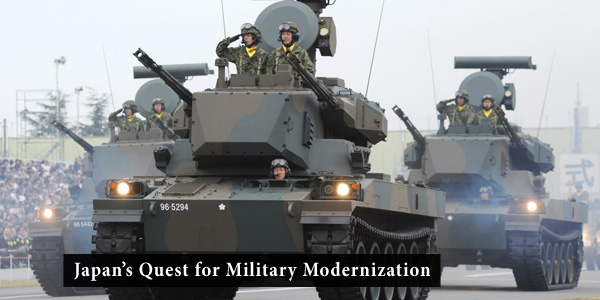Japan's Quest for Military Modernization
IRIA Staff - July 1, 2024

Japan has embarked on sweeping military modernization efforts with the most ambitious and rapid expansion of military power. The recent spendings mark the most substantial investment in defense since the establishment of the Japanese Self-Defense Forces in 1954.
This unprecedented modernization initiative seeks to bolster Japan’s deterrent capabilities and ensure readiness for potential conflicts in an increasingly uncertain geopolitical landscape. The surge in defense spending since 2017 underscores Japan’s commitment to fortifying its security posture. The record increase in defense spending by more than 16% in 2024 is aligned with Japan’s new National Security Strategy that aims to increase military expenditure to 2% of GDP by 2027.
In September 2023, the Japanese Ministry of Defense submitted a request to the country’s Finance Ministry seeking approval for a record-high 7.7 trillion Yen ($53 billion) defense budget for fiscal year 2024. Tokyo has exponentially expanded its defense spending in recent years amid increasing tensions with China and North Korea.
Japan’s pursuit of military modernization started in the year 2022 when Prime Minister Fumio Kishida unveiled a detailed ten-year plan for the country’s defense spending. According to the plan, Japan would spend at least 2% of its annual GDP on defense each year, a standard also encouraged by NATO for its member states.
In 2022, Japanese Prime Minister Kishida told his Finance Minister Shunichi Suzuki and Defense Minister Yasukazu Hamada that in the first phase of the military modernization campaign, Japan needs to urgently increase its defense budget by the fiscal year 2027. He also said that the government needs to review expenditures and revenue streams to decide how it can secure extra funding to increase the defense budget.
As proposed by the current administration, the gradual increase would total about $287 billion over the next five years. Japan typically holds are very limited approach toward defense spending. The $46 billion defense budget in 2023 was already a leap forward compared to the country’s previous defense spending. The 2024 budget would exceed last year’s budget by 16%.
Japan’s National Defense Strategy says that the country will fundamentally reinforce the current multidomain defense force and “will possess a capability that makes the opponent realize that the goal of invasion of Japan is not achievable by military means and that the damage the opponent will incur makes the invasion not worth the cost”.
This strategic realignment signifies a pivotal shift in Japan’s defense policy, previously constrained by stringent limitations on military spending. As Japan emerges as a key player in regional security dynamics, this transformation holds profound implications for the country’s role in shaping the future of East Asian geopolitics.
Japan’s Defense Objectives
Based on Japan’s National Defense Strategy released in 2023, Tokyo has three main defense objectives and plans to utilize three different approaches to attain them.
1. To shape the regional and global security environment to maintain the status quo by force.
2. To deter and respond to unilateral challenges to the regional security environment and to maintain collaboration with Japan’s allies and like-minded countries on the matter.
3. To enhance military capabilities to deal with aggression unilaterally while receiving support from allies and like-minded partners.
Japan pursues its defense objectives through a multifaceted approach that combines both military and diplomatic efforts. Tokyo’s National Defense Strategy puts a strong emphasis on enhancing defense cooperation and partnerships with like-minded countries, participating in joint exercises, information sharing, and capacity-building initiatives to strengthen regional security networks.
Japan emphasizes diplomacy and dialogue as key tools for promoting peace and stability in the region, engaging in multilateral forums and bilateral discussions to address security concerns and foster mutual understanding among nations.
Seven Fields of Fundamental Reinforcement
Japan’s latest national defense strategy has outlined that the military modernization efforts are focused on enhancing seven key areas by 2027.
1. Standoff Defense Capabilities: Strengthening of the ability to respond to the opposing forces by utilizing long-distance strike capabilities. In this regard, Japan has initiated at least two programs. First, Tokyo is acquiring U.S.-made Tomahawk missiles to enhance its long-distance strike capabilities. Secondly, Japan is working to upgrade its domestically developed Type-12 surface-to-surface long-range strike missile. The Japanese government plans to spend more the $33 billion over the course of five years to improve its standoff defense capabilities.
2. Integrated Air and Missile Defense: This program focuses on strengthening the capabilities to respond to airborne threats, including missiles. Japan has acquired, developed, and deployed several Aegis system-equipped naval vessels to enhance its missile defense capabilities. Tokyo plans to spend more than $19 billion over five years to upgrade its integrated air and missile defense capabilities. This program also includes counterstrike capabilities that leverage standoff defense capability and other capabilities in case an armed attack against Japan occurs using ballistic missiles and other means.
3. Unmanned Defense Capabilities: The importance of a strong defense capability against unmanned aerial and underwater threats has become more evident in recent years, especially after the Russia-Ukraine war. Japan is also rapidly enhancing its unmanned defense capabilities by developing and acquiring mid-range as well as long-range reconnaissance and combat drones. Tokyo is projecting to spend $6 billion by 2027 to enhance its unnamed defense capabilities.
4. Cross-domain Operation Capabilities: Cross-domain defense operation refers to the ability to manage defense operations in non-conventional domains such as space, cyber, and electromagnetic spectrum. According to the National Defense Strategy, Japan has put a strong emphasis on enhancing its defense capacities in these domains and plans to spend $53 billion over the next five years on enhancing its cross-domain operation capabilities.
5. Command-and-Control and Intelligence-Related Functions: Another strong emphasis has been put on reinforcing military command and control operations as well as integrating AI and other modern technologies into the conventional security architecture for quick and accurate decision-making. A $6 billion budget has been estimated for such upgradation of command-and-control and intelligence-related functions by 2027.
6. Mobile Deployment Capabilities and Civil Protection: To reinforce, protect, and enhance the country’s maritime and air transportation capability for rapid military maneuvering and deployment, Japan plans to $12 billion over the next five years.
7. Sustainability and Resiliency: Japan plans to spend extensively on developing a reliable military infrastructure and building up a sufficient ammunition backup as well as securing the ammunition and fuel storage facilities. A $12 billion fund has been projected to improve Japan’s sustainability and resiliency.
To Continue Reading, Download Full Report...
ALSO READ:
Regions
Issues


















 China's Ambitions at Sea and Naval Modernization
China's Ambitions at Sea and Naval Modernization Global race to develop 6th-generation fighter jets
Global race to develop 6th-generation fighter jets








